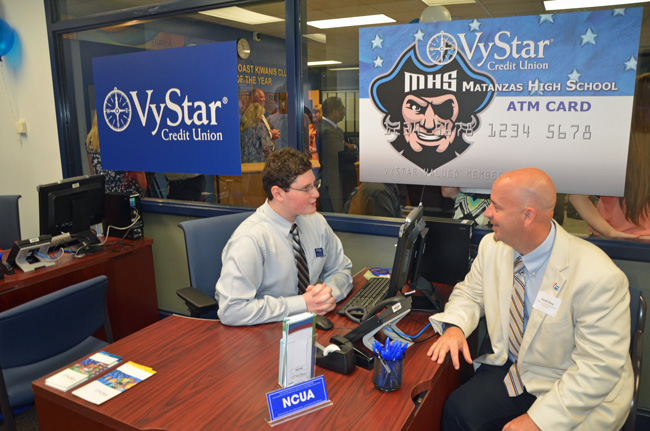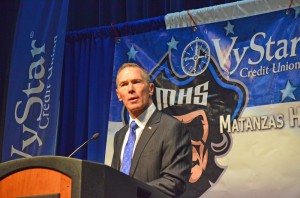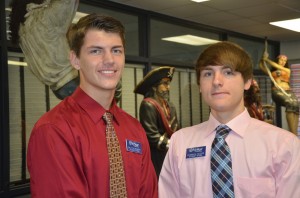
It’s a normal feature of most college and university campuses: banks, restaurants, copying, shipping or hairstyling businesses operate retail outlets on school property just as they would in a mall. They’re staffed overwhelmingly by students, giving students experience and some income, and filling specific needs on campus. The same concept is rarely visible in public schools.
Until today.
At 11 this morning, a VyStar Credit Union branch opened on the campus of Matanzas High School. It’ll be staffed by 12 students as part of a related class and two teachers—Laura Curry and Jeremy Schaefer– who will oversee the operation for the company. It is the first such partnership between the Flagler County School District and a community business (and the eighth between VyStar and schools in North Florida), combining the benefits of a service with educational aims, and directly connecting academic work with career opportunities in the here and now, on the students’ most immediate turf. The partnership is a focal point of Matanzas’ flagship program, the district-wide initiative Superintendent Jacob Oliva launched last year to emphasize relevant connections between school and career through hands-on experience for students.
To members of the school board, the VyStar partnership may be the first of many more. “As the flagship program matures,” Andy Dance, chairman of the Flagler County School Board, “we should be able to tie those into established businesses.”
Three minutes before the branch opened for business this morning, Oliva was symbolically and literally, opening an account with $20, with Fred Beyder, a junior who’s considering a career in banking, as his account representative.
“They had a wheel out there where you could win prizes,” Oliva said, as long as an account was opened. “I just want to spin that wheel so bad.”
That was Oliva’s inescapable playful side—like the pink horn-rimmed glasses he showed up with today, trying to keep up with what he calls his “GQ” staff—though the superintendent was also , well, all business when discussing the new partnership. “We want our students to not only be successful in our state exams but in life,” Oliva said, “so we have to teach beyond those minimum standards.”
The working branch of a bank does that. It looks like any other bank branch, just smaller, fitting into the 20 foot by 20 foot space previously used by the attendance office (that office moved across the way). VyStar invests roughly $150,000 per school branch. It’s got teller windows, desks, a small back office. It’s open to any student or member of the faculty and staff on campus. The branches have the same level of security as non-school branches. The one major difference between it and a branch beyond campus is loans: the Matanzas branch doesn’t offer them. Otherwise, it’s nearly full service. Its staff, dapper, congenial, eager to serve, is indistinguishable from that of any professional environment.

VyStar provided paid summer internships (at $10.10 an hour) to train students who’d eventually staff the Matanzas branch. Numerous students applied and were interviewed before the 12 were chosen and put to work for seven to eight weeks at the credit union’s Palm Coast branch at the western end of Palm Coast Parkway, near St. Joe’s Plaza, working 35-hour weeks. Some of the students still work there, as do Junior Dalton Bower and Senior Dominick Secor.

West says so far the company hasn’t seen other similar businesses try to compete with it on school campuses. But nor is the venture a money-maker for VyStar, which he says spends about half a million dollars a year to run the eight branches in schools. “Our goal is to teach financial literacy, so this is all something that’s approved by the school system, they have a curriculum, and it’s not about us making business or money,” West says. “We frankly do not make any money off of this. This is to support the schools, and help teach students and help reach out to financial literacy.”
Colleen Conklin, one of three school board members attending this morning’s opening (John Fischer was the third), considers the partnership an “incredible opportunity for our students to practice real, 21st century skills, and this is the way education should be done where students have the opportunity for relevant and real-world experience.” Conklin is not concerned about the commercialization of school campuses. The school board, she says, will provide oversight, balancing opportunities against overt commercialism, but students, she says, “are bombarded with commercialization 24/7.” A partnership such as the venture with VyStar “is a way for it to be done in a constructive and positive way.”

VyStar was founded in 1952 by 12 people with $60, and was originally known as Jax Navy Federal Credit Union, serving a naval station in Jacksonville. It’s grown to 467,000 members and assets of $5.3 billion, making it the 19th largest credit union in the nation by assets, and 13th largest by membership. It just opened its 34th branch in St. Johns County and is soon to expand in Volusia. The school branches have become an integral part of the credit union’s model.
“What we found from the students themselves,” West said, “often they’ll say I didn’t realize this might be a career opportunity for me, so they get exposed to how businesses work in the real world, what’s important, obviously in today’s world math is critically important, technology, you have to be a good reader and interpret what you’re reading, and how to interact in the people skills side of it, and frankly, how to dress. The students always dress very well. They take it very, very seriously.”





























rst says
What a wonderful idea! I believe in progressive education and this certainly fits the bill. Perhaps others will follow; the sky’s the limit!
Alan says
As an original member of Jax Navy, I’m delighted to see this latest VyStar Branch open and give
these students such an opportunity to learn about finances! BEST WISHES.
Ron R. says
Fantastic idea!
Tom C says
Thank you, FLAGLER LIVE, for publicizing this wonderful initiative. It is so nice to read positive news.
lola says
Even though you can’t use the card at school at all. The school is so happy because so many kids signed up but no one did it for the card or learning we did it for the free dress down pass because it gives us one day to not dress like a nerd in a polo ….